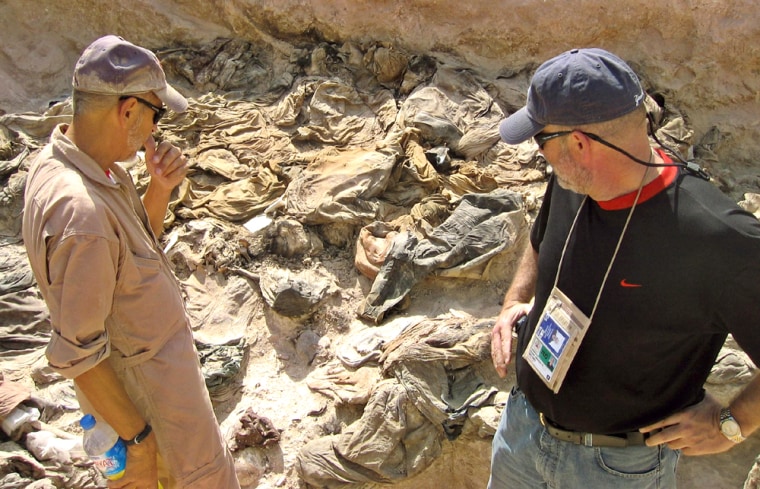Investigators have conducted their first scientific exhumation of Iraq’s “killing fields,” discovering hundreds of bodies that they hope will help convict Saddam Hussein of crimes against humanity.
They say nine trenches in a dry, dusty riverbed at the Hatra site in northern Iraq contain at least 300 bodies, and possibly thousands, including unborn babies and toddlers still clutching toys.
“It is my personal opinion that this is a killing field,” said Greg Kehoe, a U.S. lawyer appointed by the White House to work with the Iraqi Special Tribunal. “Someone used this field on significant occasions over time to take bodies up there, and to take people up there and execute them.
“I’ve been doing gravesites for a long time, but I’ve never seen anything like this, women and children executed for no apparent reason,” added Kehoe, who spent five years in the Balkans. “It’s a perfect place for execution.”
The victims are believed to be minority Kurds killed during 1987-88. One trench contains only women and children, apparently killed by small arms. Another contains only men, apparently killed by automatic gunfire.
Kehoe said the women and children had been taken from their villages with their belongings, including pots and pans, shot — often in the back of the head — then bulldozed into the trench.
Some of the mothers died still holding their children. One young boy still held a ball in his tiny arms. A thick stench hangs over the site, as well as at a makeshift morgue nearby.
“The youngest fetus we have was 18 to 20 fetal weeks. Tiny bones, femurs, thighbones the size of a matchstick,” says investigating anthropologist P. Willey of California.
40 possible mass graves identified?
International organizations estimate more than 300,000 people died under Saddam’s 24-year rule, and Iraq’s Human Rights Ministry has identified 40 possible mass graves countrywide.
Authorities hope careful investigations of the sites will provide enough evidence to convict Saddam and other senior members of his regime, now in U.S. detention, of crimes against humanity.
Investigators have excavated smaller mass graves before but never, they say, with such a methodical and forensic focus, aimed at gathering indisputable evidence of who was responsible.
Ahead of Wednesday’s expected completion of digging at Hatra, investigators took a pool reporter to the scene, who provided details for Reuters and other media.
“We’re trying to meet international standards that have been accepted by courts throughout the world,” Kehoe said. “That’s our benchmark. One of the reasons why we’re going to stop digging now is because we have a lot of work to do back at the morgue.
“That takes time. We’re putting a package together on each body removed — pictures of bones, clothes, a forensic report.”
Trial expected next year
Saddam is expected to face trial for crimes against humanity next year, but no timetable or details of the charges have yet been announced. Investigators are still pursuing evidence.
During his reign, Saddam pushed hundreds of thousands of Arabs into Kurdish areas to force the locals out. He is accused of widespread abuses against the Kurds, including the “Anfal” (The Spoils) campaign in 1988, during which thousands died in a mustard gas attack. Human Rights Watch estimates that more than 50,000 Kurds were killed during the campaign.
“Genocide is the attempt to eliminate, limit or exterminate a religious ethnic national or racial group,” said Kehoe. “The Kurds are clearly a different nationality. So could it be considered genocide? It could be.
“Killing, ethnic cleansing, property relocations, all of those were used to try to limit the Kurdish population. What it is, fundamentally, is downright murder.
“Everybody said ‘never again’ after the Holocaust. The world wasn’t listening. That’s how it happened again and again and again.”
